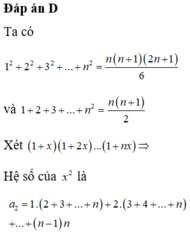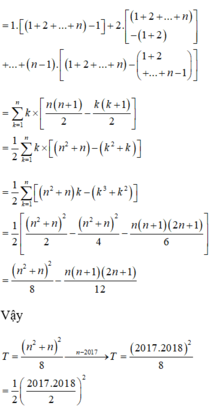


Hãy nhập câu hỏi của bạn vào đây, nếu là tài khoản VIP, bạn sẽ được ưu tiên trả lời.




Mình nhầm \(C^1_{2016}a_{2015}\)thành \(C^1_{2016}a^{2015}\)

\(\lim\limits_{x\rightarrow3}f\left(x\right)=\lim\limits_{x\rightarrow3}\frac{8x^{2016}-24x^{2015}}{x^{2017}+2x^{2016}-15x^{2015}}=\lim\limits_{x\rightarrow3}\frac{8\left(x-3\right)}{x^2+2x-15}=\lim\limits_{x\rightarrow3}\frac{8\left(x-3\right)}{\left(x-3\right)\left(x+5\right)}=\lim\limits_{x\rightarrow3}\frac{8}{x+5}=1\)
\(\lim\limits_{x\rightarrow1}g\left(x\right)=\lim\limits_{x\rightarrow1}\frac{\sqrt{2x+2}-2+2-\sqrt{3x+1}}{m\left(x-1\right)\left(x+1\right)}\)
\(=\lim\limits_{x\rightarrow1}\frac{\frac{2\left(x-1\right)}{\sqrt{2x+2}+2}-\frac{3\left(x-1\right)}{2+\sqrt{3x+1}}}{m\left(x-1\right)\left(x+1\right)}=\lim\limits_{x\rightarrow1}\frac{\frac{2}{\sqrt{2x+2}+2}-\frac{3}{2+\sqrt{3x+1}}}{m\left(x+1\right)}=\frac{\frac{2}{4}-\frac{3}{4}}{2m}=-\frac{1}{8m}\)
\(\Rightarrow-\frac{1}{8m}=1\Rightarrow m=-\frac{1}{8}\)

\(P=\left(\frac{\left(\sqrt[3]{x}+1\right)\left(\sqrt[3]{x^2}-\sqrt[3]{x}+1\right)}{\sqrt[3]{x^2}-\sqrt[3]{x}+1}-\frac{\left(\sqrt{x}-1\right)\left(\sqrt{x}+1\right)}{\sqrt{x}\left(\sqrt{x}-1\right)}\right)^{10}\)
\(=\left(\sqrt[3]{x}+1-\frac{\sqrt{x}+1}{\sqrt{x}}\right)^{10}=\left(\sqrt[3]{x}-\frac{1}{\sqrt{x}}\right)^{10}=\left(x^{\frac{1}{3}}-x^{\frac{-1}{2}}\right)^{10}\)
\(=\sum\limits^{10}_{k=0}C_{10}^k.\left(-1\right)^{10-k}.\left(x^{\frac{1}{3}}\right)^k.\left(x^{\frac{-1}{2}}\right)^{10-k}=\sum\limits^{10}_{k=0}C_{10}^k\left(-1\right)^{10-k}x^{\frac{5k-30}{6}}\)
Số hạng ko chứa x \(\Rightarrow\frac{5k-30}{6}=0\Rightarrow k=6\)
\(\Rightarrow C_{10}^6.\left(-1\right)^4=210\)

Xét 2 khai triển:
\(\left(x+1\right)^{2018}=C_{2018}^0+C_{2018}^1x+C_{2018}^2x^2+...+C_{2018}^{2018}x^{2018}\)
\(\left(x-1\right)^{2018}=C_{2018}^0-C_{2018}^1x+C_{2018}^2x^2-...+C_{2018}^{2018}x^{2018}\)
Cộng vế với vế:
\(\left(x+1\right)^{2018}+\left(x-1\right)^{2018}=2\left(C_{2018}^0+C_{2018}^2x^2+...+C_{2018}^{2018}x^{2018}\right)\)
\(\Leftrightarrow C_{2018}^0+C_{2018}^2x^2+...+C_{2018}^{2018}x^{2018}=\frac{1}{2}\left(x+1\right)^{2018}+\frac{1}{2}\left(x-1\right)^{2018}\)
\(\Rightarrow\lim\limits_{x\rightarrow1}=\frac{\frac{1}{2}\left(x+1\right)^{2018}+\frac{1}{2}\left(x-1\right)^{2018}-2^{2017}}{x-1}=\lim\limits_{x\rightarrow1}\frac{1009\left(x+1\right)^{2017}+1009\left(x-1\right)^{2017}}{1}=1009.2^{2017}\)

Giới hạn \(\lim_{x\to 1}\frac{\sqrt[2017]{2x-1}-x^{2017}}{x-1}\) được viết dưới dạng \(\frac{0}{0}\) tất nhiên nó vô định. Do đó, ta áp dụng quy tác L'Hospital
\(\lim_{x\to 1}\frac{\sqrt[2017]{2x-1}-x^{2017}}{x-1}\)
\(=\lim_{x\to 1}\frac{\frac{2}{2017}(2x-1)^{-\frac{2016}{2017}}-2017\cdot x^{2016}}{1}\)
\(=\frac{\frac{2}{2017}(2-1)^{-\frac{2016}{2017}}-2017}{1}\)\(=\frac{2-2017^2}{2017}\)
sửa đề \(\lim_{x\to 1}\frac{\sqrt[2017]{2x-1}-x^{2017}}{x-1}\)

Theo công thức nhị thức Niu-tơn, ta có :
\(P=C_6^0\left(x-1\right)^6+C_6^1\left(x-1\right)^5+....+C_6^kx^{2k}\left(x-1\right)^{6-k}+....+C_6^5x^{10}\left(x-1\right)+C_6^6x^{12}\)
Suy ra, khi khai triển P thành đa thức, \(x^2\) chỉ xuất hiện khi khai triển \(C_6^0\left(x-1\right)^6\) và \(C_6^1\left(x-1\right)^5\)
Hệ số của \(x^2\) trong khai triển \(C_6^0\left(x-1\right)^6\) là : \(C_6^0.C_6^2\)
Hệ số của \(x^2\) trong khai triển \(C_6^1\left(x-1\right)^5\) là : \(-C_6^1.C_5^0\)
Vì vậy hệ số của \(x^2\) trong khai triển P thành đa thức là : \(C_6^0.C_6^2-C_6^1.C_5^0=9\)